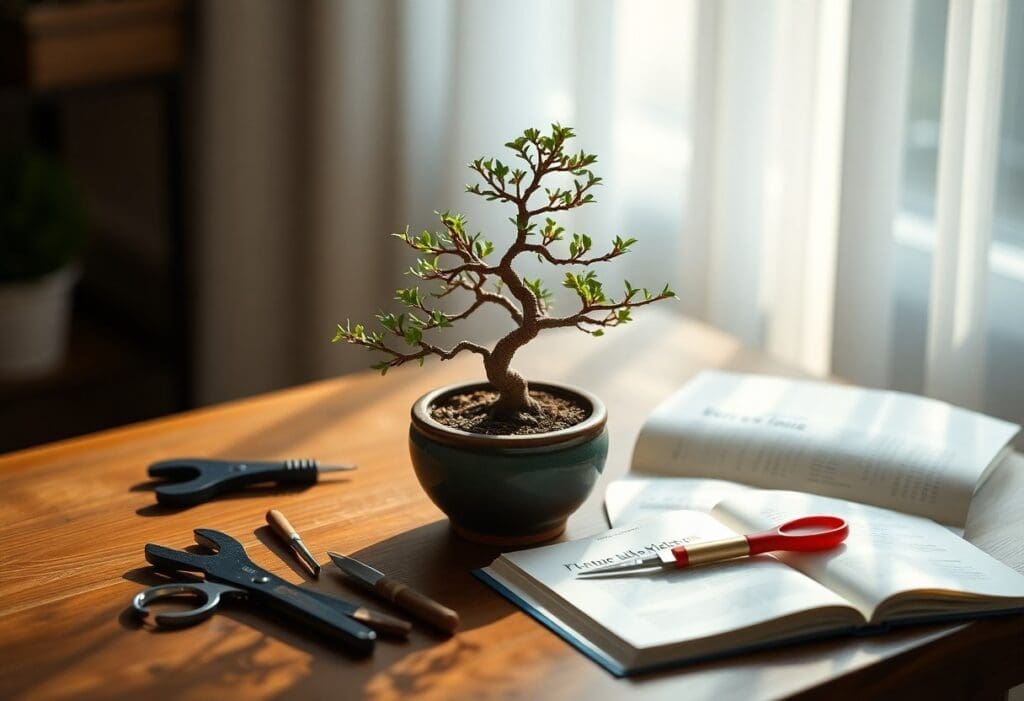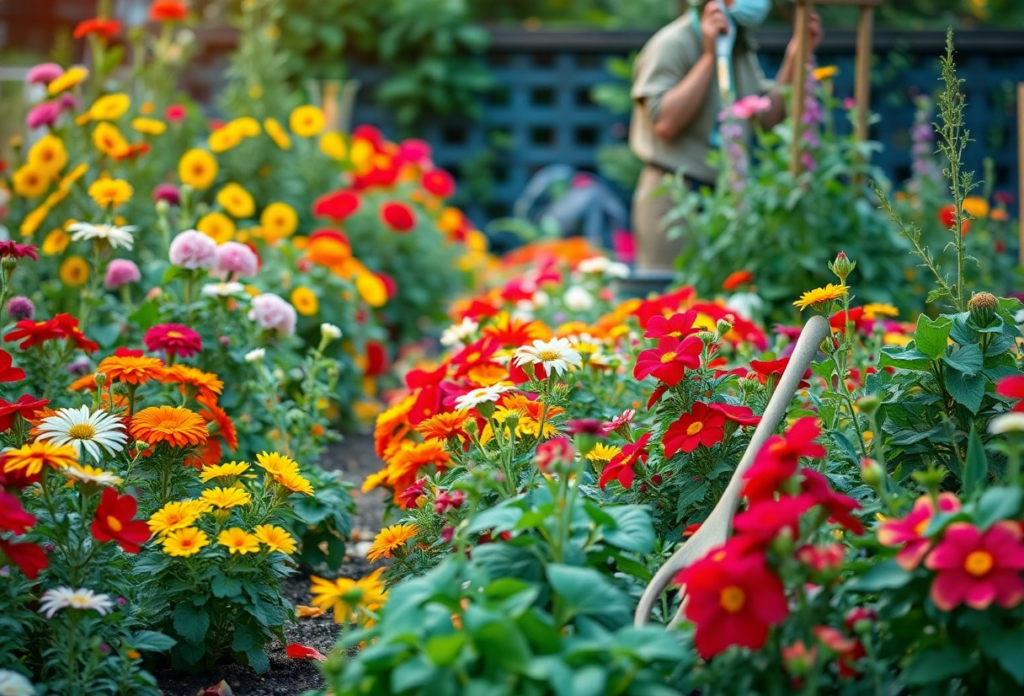Tree care is a rewarding and artistic endeavor, and your first bonsai tree can be an exciting journey into this ancient practice.
In this guide, you’ll learn the important steps and techniques to cultivate your very own miniature masterpiece.
From selecting the right tree species to understanding pruning and wiring, you’ll gain the knowledge needed to nurture your bonsai successfully.
Get ready to embrace patience and creativity as you begin on this fulfilling horticultural adventure!
Choosing the Perfect Species for Your First Bonsai
Climate Considerations
When opting for a bonsai species, you will want to match your choice to your local climate.
Tropical species, such as Ficus, thrive in warm, humid conditions. Temperate varieties like Japanese Maple prefer four distinct seasons.
Consider whether you’ll be growing your bonsai indoors or outdoors, as this will significantly influence your species selection.
Beginner-Friendly Options
Some bonsai species are notably easier to care for, making them ideal for beginners.
Options such as Juniper, Ficus, and Chinese Elm not only tolerate common mistakes but also adapt well to various environmental conditions.
These species are resilient and can withstand fluctuations in watering, which is an appealing trait for those just starting.
Junipers are particularly forgiving. They’re hardy and can thrive in both indoor and outdoor settings.
Ficus species, on the other hand, are forgiving of mishaps with watering and pruning.
Chinese Elms, known for their graceful leaves and adaptability.
They are an excellent choice, because they can handle both indoor and outdoor environments.
This, in turn, will ensure that your effort will flourish as you become more comfortable with bonsai techniques.
Assessing Growth Requirements
Each bonsai species has unique growth requirements that influence its overall health and aesthetics.
Factors such as light exposure, watering frequency, and soil composition vary widely among different types.
Understand these specific needs, and you can create a nurturing environment for your bonsai.
For instance, Ficus trees thrive under bright, indirect light and appreciate regular misting to maintain humidity levels.
Conversely, Junipers prefer direct sunlight and drier conditions.
By taking the time to research and understand these requirements, you set yourself up for success. You’ll be able to ensure that your bonsai not only survives but thrives as well.
Essential Tools for Bonsai Cultivation
Your bonsai toolkit starts with a few necessary tools.
A quality pair of bonsai shears is indispensable for precise pruning, while concave cutters allow you to remove branches without leaving unsightly scars.
Wire cutters help maintain the shape of your tree as it grows.
A good set of tweezers is perfect for delicate work, such as removing unwanted foliage or debris.
If you want to make it easy, you can pick up a full bonsai toolkit on Amazon for around $50.
These fundamental tools enhance your ability to nurture and sculpt your bonsai effectively.
The Art of Potting: From Soil to Container
Selecting the Right Pot
When choosing the right pot for your bonsai tree, you’ll have to focus on much more than aesthetics.
Look for a container that matches the size and style of your tree while allowing for proper drainage.
You want a pot that is approximately two-thirds the height of the bonsai to ensure stability, yet with enough depth to accommodate the roots.
Traditional bonsai pots often feature drainage holes and may be made from clay or ceramic, which can help in moisture regulation.
Soil Mixtures and Their Impact
A high-quality soil mixture can greatly affect your bonsai’s health and growth.
Ideal bonsai soil typically contains a balance of organic materials like peat and inorganic components such as pumice or gravel.
This type of soil base allows for proper drainage while retaining important moisture.
The composition varies based on the species, climate, and age of your bonsai. You will need to tailor your mix to create the ideal growing environment.
For example, younger bonsai trees may thrive in a mix designed for quick drainage to prevent root rot. Meanwhile, more mature trees can benefit from a richer blend that retains some moisture.
Use a mix that includes additives such as akadama. This can enhance aeration and moisture retention, benefiting root development significantly.
Familiarize yourself with the specific needs of your tree species to ensure optimal growth and vitality.
Techniques for Proper Potting
The potting process can significantly influence your bonsai tree’s success.
Begin by lightly trimming the roots before placing the tree in its container to encourage healthy growth and a robust root system.
Position the tree at an angle if needed, ensuring it appears natural and harmonious within the pot.
Fill in with your chosen soil mixture, gently compacting it to eliminate air pockets while still allowing for airflow around the roots.
While potting, focus on avoiding excessive pressure that could damage delicate root hairs.
After positioning your bonsai in the pot, water thoroughly to settle the soil around the roots.
Regularly check for drainage and moisture levels to establish a healthy environment for your bonsai.
Proper potting can set the foundation for a thriving bonsai, allowing you to shape and refine it as it grows.
Mastering the Fundamentals of Pruning
The Science of Shaping Your Bonsai
Bonsai tree pruning is an art grounded in science, blending horticultural knowledge with creative expression.
The practice involves removing specific branches and leaves, which helps control the tree’s growth and directs energy to desired areas.
By maintaining the right balance between foliage and root systems, you promote healthy development while allowing your bonsai to take on the intricate shapes you envision.
By understanding the tree’s natural growth patterns, you will be able to shape it in a way that respects its biological rhythms.
Seasonal Pruning Best Practices
Timing is key in bonsai pruning. Let the seasons guide your approach.
For most bonsai species, late spring or early summer is ideal for structural pruning, as the tree’s growth is vigorous and can recover quickly.
In contrast, fine-tuning and maintenance pruning can be carried out in late summer to early fall, just before the dormant winter period.
This systematic approach helps ensure that your tree remains healthy and maintains its aesthetic appeal throughout the year.
For example, if you’re working with a Japanese maple, pruning in late spring is ideal.
The sap flow is highest during this time, allowing for optimal healing after cuts.
Similarly, pines often benefit from a technique called ‘candling’ in late spring, where you prune new shoots to control their length.
By aligning your pruning methods with the seasonal cycles specific to your bonsai’s species, you will not only enhance its beauty but also strengthen its overall resilience.
Common Pruning Mistakes to Avoid
Many beginners make errors that can jeopardize their bonsai’s health.
Over-pruning is a frequent mistake, leading to shock and stunted growth.
Additionally, improper tools or technique—such as jagged cuts or improper angles—can damage your tree.
You’ll have to understand when to take a step back. Sometimes less is more.
Over-pruning can lead to a loss of foliage that’s important for energy production.
For instance, if you remove too many leaves at once, your tree may struggle to photosynthesize effectively.
Dull or inappropriate tools can create uneven cuts that invite disease.
Always make clean cuts with sharp tools and evaluate your tree’s health before initiating any pruning.
You will find that these techniques will help you develop a stronger, healthier bonsai with each season.
Watering Wisely: The Balance Between Hydration and Drought
Identifying Water Needs for Different Species
Each bonsai species has unique water requirements.
Tropical species, for example, typically require more frequent watering due to their preference for moist conditions. On the other hand, conifers prefer a drier soil environment.
Research your specific tree, whether it’s a Ficus, Juniper, or Pine. This will guide you in determining an appropriate watering schedule.
Your plant’s leaf color and general vigor can also provide insights into its hydration needs.
Techniques for Effective Watering
To maintain the vitality of your bonsai tree, you’ll need to make sure your approach to watering is on point.
Water thoroughly until it runs out of the bottom drainage holes, ensuring that roots receive moisture evenly.
A moisture meter can also be a handy tool, helping you gauge when it’s the right time to water.
Additionally, consider the time of day. To minimize evaporation loss, water during early morning or late afternoon.
A watering can with a fine spout will help you to control the flow and distribute water evenly, preventing soil erosion.
Techniques like bottom watering in a tray can help provide moisture without directly saturating the foliage.
Additionally, mulch can help retain soil moisture, reducing your watering frequency while promoting a healthy root system.
Signs of Overwatering vs. Underwatering
You will have to be able to identify signs of overwatering and underwatering. It will vastly improve your bonsai care.
Yellowing leaves or a mushy root system often indicate waterlogging. Conversely, dry, crispy leaves and wilting stems can signal insufficient moisture.
Regular inspection of leaf health and soil moisture levels will help you recognize these signs early.
An effective way to distinguish between the two conditions is soil feel.
Overwatered soil tends to cling together and feels heavy, while underwatered soil is dry and crumbly.
Monitoring these changes in soil texture and appearance will enable you to adjust your watering habits accordingly, ensuring your bonsai flourishes and maintains its beauty.
Feeding Your Bonsai: Nutritional Needs Simplified
Choosing the Right Fertilizers
The proper fertilizer for your bonsai tree can significantly enhance its growth and overall health.
Organic options, such as fish emulsion and seaweed extract, are favored for their slow-release nature and natural nutrients.
If you prefer something more standardized, a balanced NPK fertilizer (Nitrogen, Phosphorus, Potassium) with equal ratios can promote vigorous development.
Pay attention to the species of your bonsai, as specific trees may thrive better with tailored formulations.
Key Nutrients for Healthy Growth
Nitrogen, phosphorus, and potassium are the primary nutrients your bonsai requires for healthy growth.
Nitrogen promotes lush foliage, phosphorus supports root and flower development, and potassium enhances overall plant vigor.
By providing your bonsai with a balanced mix of these nutrients, you can ensure robust and sustained growth, allowing your tree to thrive in its miniature environment.
Beyond the important macronutrients, trace elements like iron, magnesium, and calcium play vital roles as well.
Iron is particularly important for chlorophyll production, aiding in that deep green foliage you admire.
Magnesium influences photosynthesis and nutrient uptake. Calcium strengthens cell walls, promoting a sturdier plant structure.
When you aim for a well-rounded diet for your bonsai, consider incorporating these key nutrients to support long-term vitality.
Feeding Schedules Throughout the Year
Your bonsai tree’s nutritional needs will fluctuate with the changing seasons, making a feeding schedule important.
During the active growing season, typically spring and summer, you should feed your bonsai every four to six weeks to support new growth.
In the fall, reduce feeding as the tree prepares for dormancy, and cease in winter when growth slows or halts completely.
Pace your feeding schedule to sync with your bonsai’s growth cycle.
As temperatures rise and daylight increases in the spring, your bonsai becomes more active, needing regular nourishment.
Stay consistent with scheduled feedings. This will help your tree utilize nutrients efficiently, leading to optimal health and aesthetics.
As winter approaches, tapering off will ensure your bonsai conserves energy, setting it up for successful growth when the season changes again.
Troubleshooting Common Issues and Pests
Identifying Growth Problems Early
Recognizing signs of distress in your bonsai tree can significantly enhance its chances of recovery.
Look for yellowing leaves, stunted growth, or premature leaf drop as indicators that something may be amiss
Regular observation will help you catch these problems early, allowing you to take corrective measures before the issues escalate.
A weekly inspection is often sufficient to keep track of your bonsai’s health.
Natural Remedies vs. Chemical Solutions
When choosing between natural remedies and chemical solutions, you will have to take careful consideration of your bonsai’s needs.
While chemical treatments can be effective, they may also pose risks to your plant and the environment.
Conversely, natural remedies often support a holistic approach. These products rely on organic materials that can enhance the health of your tree without introducing harmful substances.
Organic solutions such as neem oil, insecticidal soap, or garlic spray can provide effective pest control while promoting ecological balance.
For instance, neem oil works by disrupting the life cycle of pests, thus minimizing re-infestation without harming beneficial insects.
When faced with a pest problem, these natural options can integrate seamlessly with your gardening philosophy and ensure your bonsai thrives.
Preventative Care Strategies
You’ll be better positioned to preventing issues BEFORE they arise with some proactive measures.
This includes maintaining a consistent watering schedule, ensuring proper drainage, and using high-quality soil.
Keep your bonsai in an environment with sufficient light and airflow. This can also deter pests and disease, creating a more resilient plant overall.
Consider implementing a routine care schedule that encompasses seasonal adjustments based on your bonsai’s growth patterns.
For instance, in spring and summer, your tree will require more frequent watering as it actively grows.
In fall and winter, however, you’ll want to adjust your care practices to help it conserve energy.
Pair these routines with regular nutrient supplementation to fortify your bonsai against potential problems.
Creating a Personal Aesthetic: Styling Your Bonsai
Understanding Bonsai Styles
Various styles define the art of bonsai, each offering a unique representation of nature.
Common styles include Formal Upright, Informal Upright, Cascade, and more, each with its own aesthetic appeal and growth technique.
These styles can help guide you in shaping your bonsai. That way, you will be able to convey your personal vision and connection to the natural world through your trees.
Techniques for Creating Visual Interest
Try things like varying trunk thickness, branch placement, and leaf density. Each of these can create depth and allure in your bonsai.
Attention to these details brings life to your tree, turning a simple plant into a captivating work of art.
Incorporate techniques such as wiring to shape branches, creating angles through pruning, and layering foliage. These can enhance the visual dynamics of your bonsai.
Consider creating negative space, allowing the eye to rest and appreciate the intricacies of your tree’s form.
Use contrast in branch lengths and thickness to create tension and harmony. This will tailor these aspects to fit the chosen style while making each element work in concert for a complex, inviting display.
Balancing Artistry with Nature
Navigating the delicate balance between artistic vision and the natural growth patterns of your bonsai is imperative.
Your stylistic choices should enhance the tree’s innate characteristics rather than overpower them, allowing each bonsai to tell its own story.
By observing your tree’s growth and adapting your techniques, you ensure that your aesthetic aligns harmoniously with nature.
Striking this balance requires patience and keen observation.
Your bonsai’s silhouette and structure must reflect its species’ natural growth habits.
For instance, a pine tree thrives with an upright stature, while a cascading style suits willows better.
By allowing nature to guide your artistry, you create a bonsai that is both a personal expression and a genuine tribute to the living world it stems from.
The Long-Term Journey: Maintaining Your Bonsai Over Time
Seasonal Care and Adjustments
Each season brings different challenges and responsibilities for your bonsai.
In spring, you’ll want to focus on repotting to encourage growth and nutrient absorption.
Meanwhile, summer demands frequent watering and protection from intense sunlight.
Autumn is the time for pruning and shaping, preparing your tree for winter’s dormancy.
During winter, ensure your bonsai has adequate protection from frost, either by moving it indoors or wrapping it securely if it’s outside.
You’ll want to adjust care based on seasonal changes. This will enhance the vitality of your tree, ensuring it thrives throughout the year.
Documenting Progress and Changes
By keeping a journal of your bonsai’s journey, you can glean valuable insights around its development.
Write down your observations, care routines, and any alterations made, along with photographs capturing its growth stages.
This documentation not only enables you to learn from your experiences but also connects you to the transformation of your tree over time.
As your bonsai evolves, referring back to your journal allows you to track patterns and identify what methods work best.
You might notice which pruning techniques lead to healthier branches or how different watering schedules affect leaf growth.
Beyond mere record-keeping, this approach nurtures a deeper appreciation for the process of growth and refinement.
Your documented experiences become invaluable resources for both you and future bonsai enthusiasts.
Connecting with the Bonsai Community
Fellow bonsai enthusiasts can enhance your understanding and enjoyment of the art form.
Local clubs, online forums, and social media groups offer platforms to share your progress, seek advice, and exchange tips and techniques with others who share your passion.
The bonsai community can open doors to a wealth of knowledge, offering you insights that you may not encounter solo.
Local clubs often host workshops and exhibitions where you can see various styles and techniques in action, gaining inspiration for your own work.
Online forums allow for vibrant discussions and support.
And when you share sharing your journey, you’ll be inviting feedback and suggestions that can elevate your bonsai skills.
Overall, a supportive network will enrich both your practice and passion for bonsai.
Summing up
Your first bonsai tree is an engaging and rewarding journey that allows you to connect with nature while developing your patience and creativity.
By selecting the right species, understanding the basics of care including watering, pruning, and wiring, and creating a nurturing environment, you set the foundation for a thriving bonsai.
As you cultivate your tree, you will not only gain practical skills but also a sense of accomplishment as you witness its transformation over time.
Embrace the process, and enjoy each step of nurturing your bonsai tree into a work of art.


